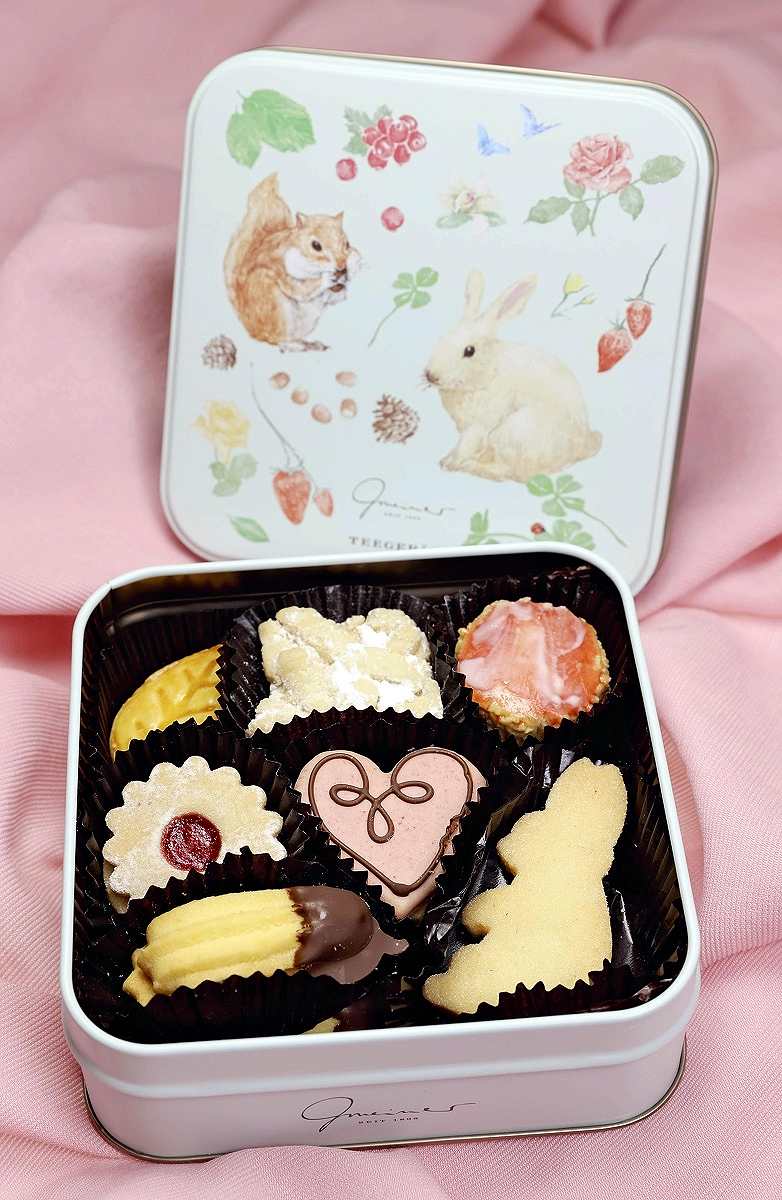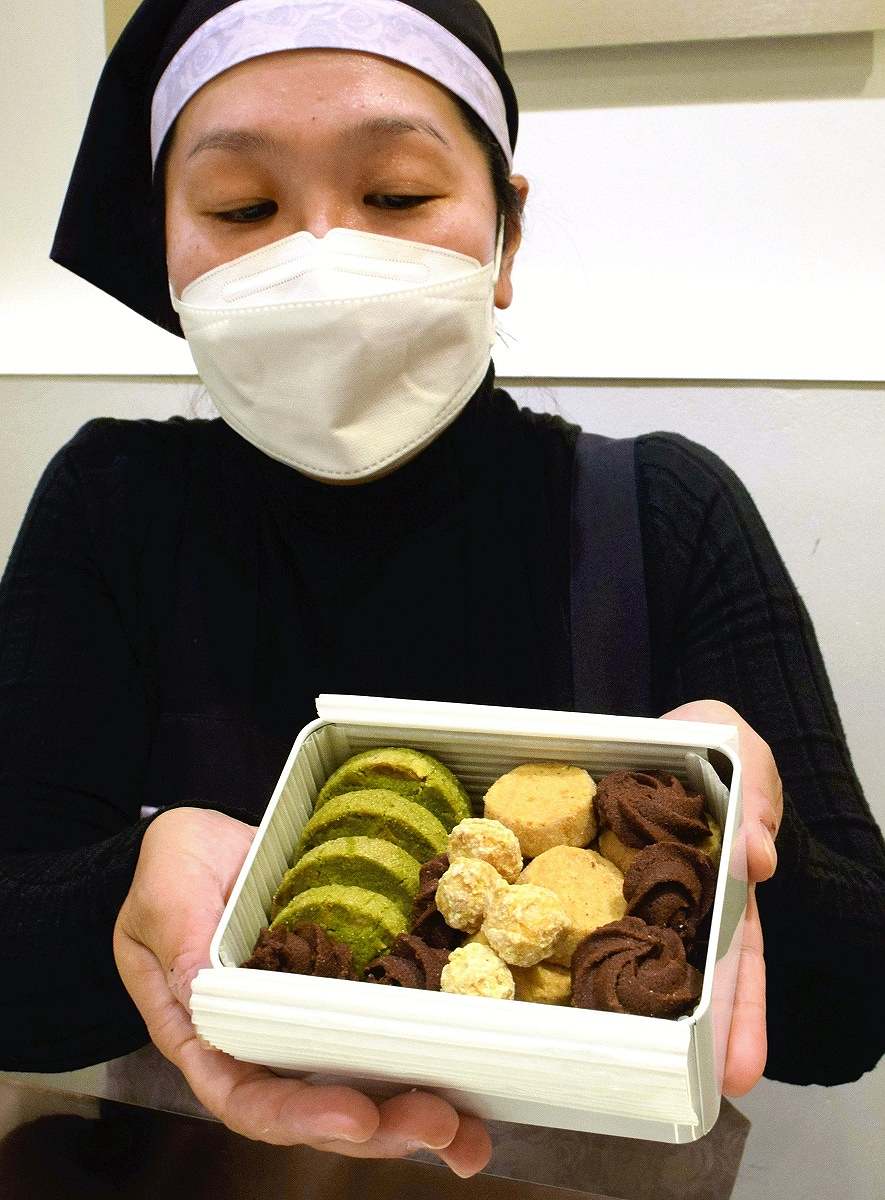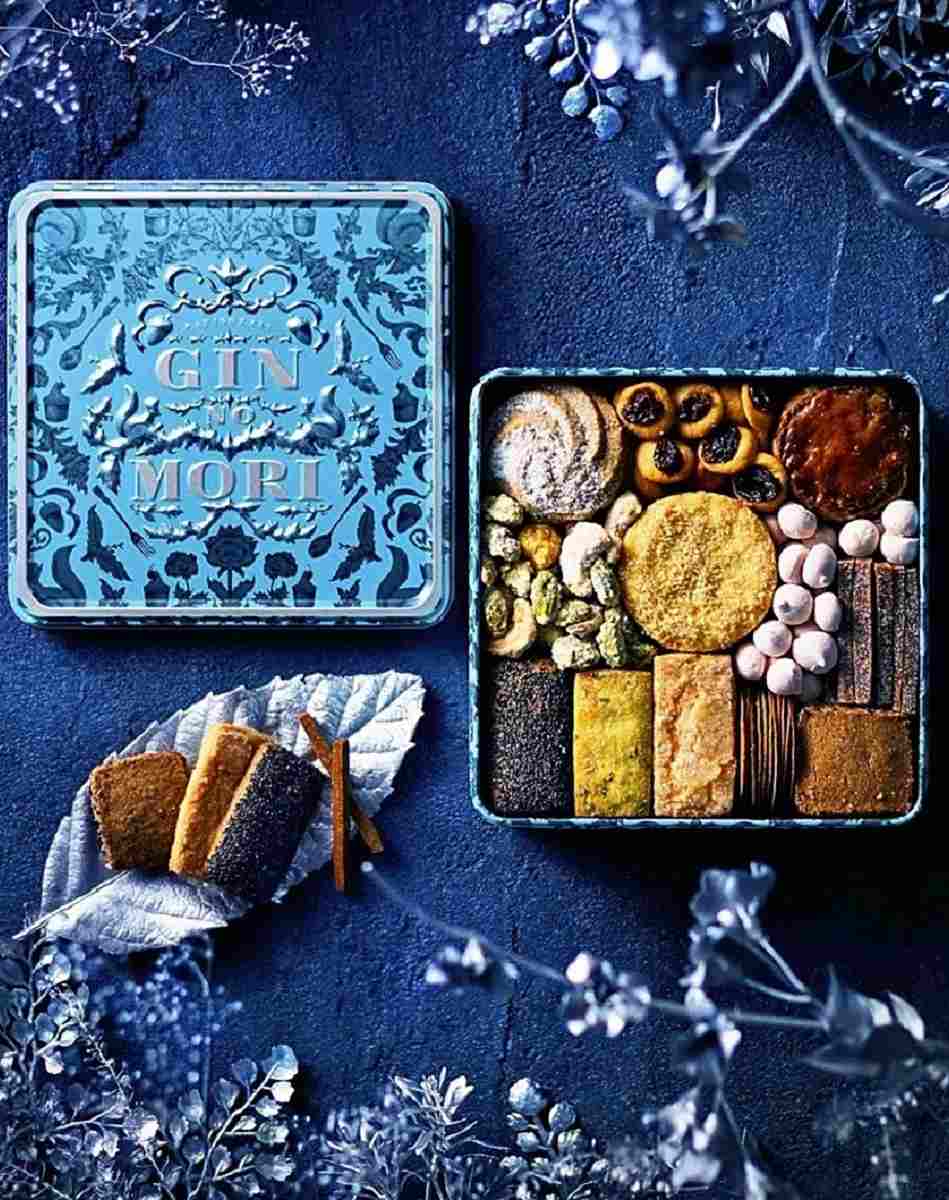
A cookie tin from German confectionery maker Gmeiner, which features a rabbit-shaped cookie
13:30 JST, January 14, 2024
Steel cans, filled with cookies of various flavors and shapes, have become popular again. What attracts people to cookie tins?
In late November, most shops were selling cookie tins in the confectionery section of the Nihombashi Takashimaya department store in Tokyo. Among the tins, products of the Tokyo-based confectionery maker Ryoura are particularly popular. Colorful anemones are depicted on the tins, which are double-palm-sized and filled with richly flavored cookies that crumble in the mouth. Since the Ryoura shop opened at the department store last year, its cookie tins have usually sold out soon after hitting the shelves.

A shop clerk shows cookies made by confectionery maker Ryoura packed in a double-palm-sized steel can at the Nihombashi Takashimaya department store in Tokyo.
German confectionery maker Gmeiner has also seen its cookie tins, which have illustrations of plants and animals, received well with an array of cookies in the shape of rabbits, leaves and hearts.
“They all look pretty and delicious,” said a 33-year-old company employee of Tokyo, who was looking for a farewell gift for his colleague.
Patisserie Gin no Mori based in Gifu Prefecture has launched its store at Azabudai Hills, a multiuse complex in Tokyo that opened on Nov. 24. Its popular product is an assortment of cookies that make use of ingredients from the forest, such as acorns and brambles. The company has offered products only available at this shop, already attracting a number of customers.

Patisserie Gin no Mori’s cookie tin, which resembles a jewelry box
The Umeda main store of the Hankyu department store in Osaka has held an annual event featuring cookies since 2018. According to the department’s official, the number of shops offering cookie tins have been increasing every year.
“Cookie tins, which are filled with a wide variety of cookies, can become signature products for shops to differentiate themselves,” he said. “Customers can also enjoy finding their favorites and tasting them.”
When did such cookie tins appear in the first place? According to confectionery tin researcher Pu Nakata, the use of cans became widespread in Japan in the early 1900s as containers for confectionery items, tea, and nori seaweed. During the period of the nation’s rapid economic growth after World War II, cookies and other confectionery products packaged in cans appeared one after another amid the spread of the gift-giving practice.
Founded in 1927, Izumiya Tokyoten Co. based in Kawasaki was the first company in Japan to sell cookies and offer cookie tins. Cookies are said to have sold well as people bought them as gifts for relatives who had scattered after WWII when they gathered. Many people keep the cans after eating cookies and use them to contain letters, sewing kits or other items.
“We are happy that the cans have been affectionately used as containers filled with nostalgia and memories,” Izumiya President Yukiko Izumi said.
According to Nakata, cookie tins are booming for the second time since the first surge in the 1970s. Previously, large cookie tins were widely favored as gifts, but due to changes in family structures and social interactions, cookie tins with a size of 12 centimeters are currently the mainstream, making them suitable for personal use or as small souvenirs. In addition, cookie tins have diversified in designs and prices.
Due to the COVID-19 pandemic, demand for such tins has also risen among on-line customers.
“Tins, which are made elaborately with no visible joints and perfectly overlap pictures on the corners and lids, are lined with cookies in tight rows. They remind people of the aesthetics of laying out food in a boxed lunch box or a stacked-up meal,” Nakata said. “Many people may have noticed the craftsmanship and meticulous technique that are distinctive to the Japanese ones.”
Hiroshi Daimoto, a professor of Tezukayama Gakuin University who conducts research on psychology regarding sweets, said, “Cookie tins have a good balance between familiarity and novelty.”
“They have long been familiar sweets close to people, and there are also a surprise and joy in terms of designs of the tins and when people open the lid,” he added. “The tins are filled with many elements that bring about happiness.”
“I think there are few sweets that people have seen in their lives longer than cookie tins,” Daimoto added.
In retrospect, my great-grandmother always kept a blue cookie tin in her home when I was a child. I think that such nostalgic feelings may be another reason for cookie tin’s popularity.
Tins usable in many ways
People can continue enjoying cookie tins even after eating the cookies.
The Japanese and Western confectionery section of the Daimaru Tokyo department store in Tokyo suggests that customers use empty cookie tins as storage boxes. A tin from the Sable Michelle shop at the department store measures about 12 centimeters by 8 centimeters, and is suitable for storing business cards and shop cards.
RoomClip, a website for sharing room and lifestyle photos, has presented many examples of how cookie tins can be used as interior decorations. One example shows a circular can used as a pot for succulent plants, while a hexagonal can is turned into a clock.
“Secondhand” cookie tins have also caught on. According to the flea market app Mercari, transactions involving the word “cookie tin” in 2023 doubled from three years ago. Some empty cookie tins with seasonal designs and those of high-end brands have fetched several thousand yen each.
"Features" POPULAR ARTICLE
-

Sanrio to Open Museum in Yamanashi Pref. Dedicated to Founder, Exhibits Include Hello Kitty, Other Characters
-

Autumn Foliage Surrounds Visitors to Tokyo’s Showa Kinen Park
-

My Daughter No Longer Speaks to Me, But I Want to See Her and My Grandchild
-

Kumamoto: Public Bath Refurbished as Library Where You Can Chat, Take Photos
-

Frozen Vegetables: Demand Rises for Convenient, Tasty Domestic Produce
JN ACCESS RANKING
-

Tokyo Economic Security Forum to Hold Inaugural Meeting Amid Tense Global Environment
-

Keidanren Chairman Yoshinobu Tsutsui Visits Kashiwazaki-Kariwa Nuclear Power Plant; Inspects New Emergency Safety System
-

Imports of Rare Earths from China Facing Delays, May Be Caused by Deterioration of Japan-China Relations
-

University of Tokyo Professor Discusses Japanese Economic Security in Interview Ahead of Forum
-

Japan Pulls out of Vietnam Nuclear Project, Complicating Hanoi’s Power Plans
























